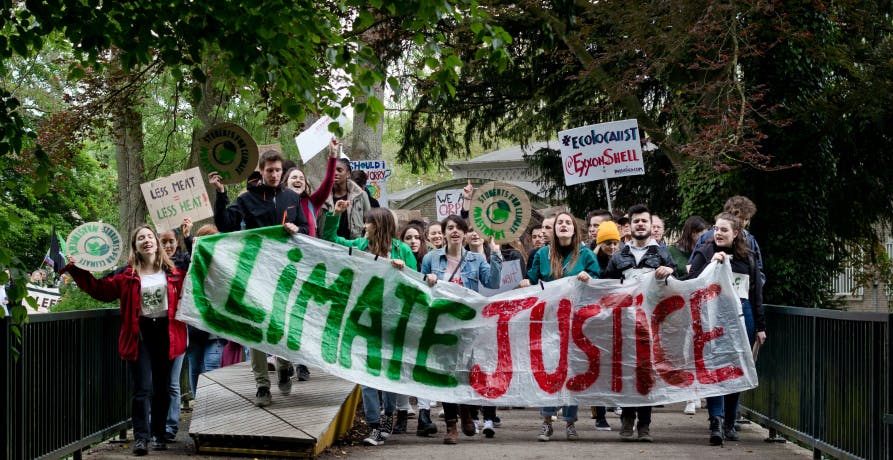
California Climate Accountability Package: SB253, SB261, & SB252
What is the California Climate Accountability Package, and how do SB 253 and SB 261 (SB 219), and SB 252 help the state work towards their environmental goals?
ESG / CSR
Industries



Climate change has been a big topic throughout 2023, with global emissions failing to curb themselves and have continued to rise exponentially. As sustainability and environmental regulations become more apparent heading into 2023 – it can get confusing to keep track of all of the new environmental regulations in the U.S. to date.

What environmental regulations did the U.S. successfully establish in 2022, and what are the current environmental regulations in 2023?
We’re about to break down all of the current environmental regulations, and the ones expected to occur in the U.S. in 2023.
Environmental regulations are governmental incentives or laws passed in attempts to protect the environment in a variety of ways: such as by reducing waste, requiring companies to cut back on production in order to reduce nation-wide emissions, or banning the use of harmful chemicals and substances to protect the environment, human health, and biodiversity.
In general, environmental regulation is dedicated towards the initial activities at the production site and how the waste is handled following the manufacturing process of a product.
The main goal of environmental regulation is to require strict rules on the measures necessary in order to reduce emissions and protect the environment – many of which would not occur if it weren’t for environmental regulations. Environmental regulations have been successful in establishing eco-friendly imperatives for companies around the world, however – there is always room for improvement, as some companies will view environmental regulations as an exorbitant business cost that is impossible to pay.
Think of the many rules and regulations regarding parking a car on the street or in a parking lot. There are a million different ways to park, “illegally” – such as parking your car on the street not facing the flow of traffic, parking in a handicap spot without a handicap pass, or parking somewhere near a meter without putting enough money in the meter before leaving. If it weren’t for all of these rules regarding parking, everyone would be likely to park whenever and wherever they want to. However, these parking laws keep people from parking as they wish – and ultimately help to improve the safety of all those on the road. Environmental regulations do the same: many wouldn’t commit to the environmental measures necessary on their own, but with the environmental regulations – it no longer becomes a choice, but a legal requirement that makes a global difference.

Without environmental regulation, it would be difficult to maintain or improve the quality of the environment. Although many businesses may view environmental regulations as a nuisance – but environmental regulations are precisely what have kept global emissions from spinning further out of control than they already have. Therefore, environmental regulations are pivotal for the future of the planet.
History even shows that environmental regulations have led to a wide-variety of other benefits. For instance, the discovery of new scientific evidence that confirm that environmental regulations are indeed necessary given the current state of climate change. Also, environmental regulations have spurred the use of new technologies such as wind energy and nuclear energy, which serve as more sustainable sources of energy. Ultimately, environmental regulations can reduce business expenses down the line – and prevent costly fees to rectify environmental damage.
The U.S. made several great leaps in terms of environmental regulations in 2022 – with two of the most notable milestones being the Biden administration’s passing of the Inflation Reduction Act of 2022, and several new legislative measures being taken in the state of California to reduce emissions.
The new climate bill, otherwise known as the Inflation Reduction Act of 2022, allocated a massive $369 billion dollars towards various climate-change related endeavors – such as by providing tax reductions for Americans that opt to build their homes with solar panels, businesses that purchase a carbon capture and storage system, or people who purchase an electric cars instead of gasoline vehicles that further pollute the atmosphere. This new climate bill also fines companies that exceed new federal limits on the use of harmful substances such as methane – meaning this new environmental regulation provides a monetary incentive to keep businesses from producing excessive emissions.
In addition to the Inflation Reduction Act of 2022, which served as the most revolutionary climate bill to date in the U.S. with the most funds ever to be allocated to climate change – California also released a series of new environmental regulations in September. Some of these include improving public transportation, banning the use of gasoline powered cars from 2035 onward in order to reduce emissions, and enhancing the wildfire protection program. These new environmental regulations are shelling out a whopping $54 million billion dollars as an attempt to reduce emissions across the state – where over a tenth of the American population lives.
However, there were several environmental regulations intact before the passing of these new environmental regulations in California and the Inflation Reduction Act of 2022.

Which environmental regulations in the U.S. have proven most successful?
New environmental regulations are becoming more common throughout the U.S., but the ones that have been intact and well functioning for a long time shouldn’t be forgotten.
Given the fact that ozone depletion and pollution continue to rise at an unprecedented rate, it may seem easy to write-off the clean air act from having been successful – but it has helped the health and saved the lives of many Americans.
The Clean Air Act is an environmental regulation that aims to address air pollution and the quality of the air – both of which are impacted by excessive carbon dioxide emissions. The act was even successful in phasing out the use of lead-based gasoline. 25 years later, according to the Centers for Disease Control and Prevention, the act succeeded in reducing the amount of lead-infused blood levels in children from 88% all the way down to 4% – and saved nearly 12,000 lives between 1968 and 1998.
Biodiversity directly impacts climate change – as wildlife, water, and plants that exist everywhere in the world help the planet to thrive. Without the endangered species act – many animals would be extinct today. The endangered species act is the only environmental legislation that is dedicated towards protecting life besides mankind, and has successfully kept species such as grizzly bears, red wolves, key deer, and peregrine falcons from going extinct.
This environmental regulation has been amended several times in order to keep up-to-date with the new measures necessary to protect fresh water systems such as rivers, lakes, and streams through the country. The Clean Water Act has helped to rectify freshwater systems that have suffered from oil spills, and continues to be modified to adhere to the climate change issues we face today.
The Montreal Protocol started back in 1987, but it’s continued to do a world of good – and is often recognized as one of the globe’s most successful international treaties. This environmental legislation has helped to remove the use of several ozone-depleting substances and helped to prevent over 1.5 million cases of skin cancer, 129 million cases of cataracts, and a whopping 330,000 prevented deaths from sun-related cancers.
All of these existing environmental regulations beg the question if new and improved legislation will join the list of these successful acts and treaties in the coming year.
If the U.S. was just dipping their toes in the water with environmental regulations in 2022, then the nation is going for a full on swim in 2023. In fact, the U.S. Environmental Protection Agency, otherwise known as the EPA, recently announced in November that there are plans in motion to implement stricter regulations regarding greenhouse gas emissions for large vehicles by 2023 until at least 2030 – perhaps in line with the UNGC’s Sustainable Development Goals also known as Agenda 2030.
While this new environmental regulation isn’t expected to go under review until March 2023, this new environmental regulation will allow for more stringent measures on hesby duty vehicles – which could greatly help to reduce the emissions created during transportation throughout the country.
Another example is how the U.S. is likely to move more towards a , “circular economy” in 2023 – which is a framework dedicated towards mitigating global issues such as climate change, protecting biodiversity, and preventing excess waste. This is in large part due to the recent “Beyond Petrochemical” campaign released by Bloomberg Philanthropies’ – with a whopping $85 million donation towards preventing plastic pollution and in turn – garnering attention towards ESG values and the prevention of further greenwashing. As sustainability and protecting the environment becomes more of a priority for large U.S. companies, especially with the release of campaigns such as these, new environmental regulations regarding the use of wasteful or harmful substances can be expected in 2023.
One of the biggest environmental regulations to come in 2023 in the U.S. is the requirement from the SEC, or the Securities and Exchange Committee, to demand more companies to disclose their financial information regarding the use of oil and gas production. This will not only increase transparency by allowing the U.S. to fully analyze the true usage of these finite resources in businesses across the country, but it will help to protect investors from investing in companies that continue to do harm to the environment. All around, this new environmental regulation to be implemented by the SEC will create a domino effect of protection for the environment. If investors are more aware of the expenditures regarding finite resources of the company they may potentially invest in – then they are less likely to financially support companies that fail to comply with the environmental measures necessary. Therefore, this environmental regulation to be put in motion by the SEC will serve as a big step forward for the U.S. in protecting the environment and curbing emissions in 2023.

Will these environmental regulations help the U.S. to curb emissions in 2023?
In combination with the pre-existing environmental regulations established before 2022, the new ones passed this past year, and the environmental regulations expected in 2023 – there seems to be a novel light of hope for emissions to be reduced in the U.S. and ultimately move towards greater sustainability.
The good thing about all of these current and upcoming regulations is that they require companies to comply with the new environmental regulations – or face a hefty fine. This means that these new environmental regulations are likely to help curb emissions in certain areas, but there is still a lot of work to be done. For instance, companies still have little control over the emissions created by their suppliers or face difficulty reducing their scope 3 emissions.
Drastic measures are compulsory if the world wants to prevent the global surface temperature from getting higher than it already is, and while these environmental regulations aren’t surefire – they are a step in the right direction.
If reading this article about the environmental regulations in the United States in 2023 has made you interested in reducing your carbon emissions to further fight against climate change – Greenly can help you!
Greenly can help you make an environmental change for the better, starting with a carbon footprint assessment to know how much carbon emissions your company produces.